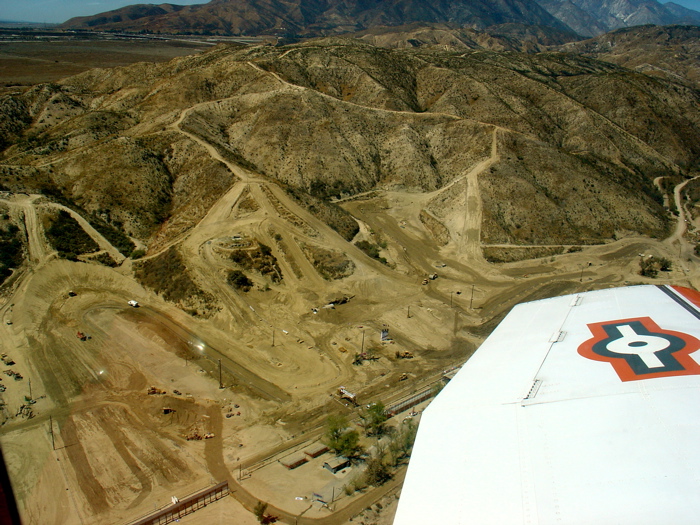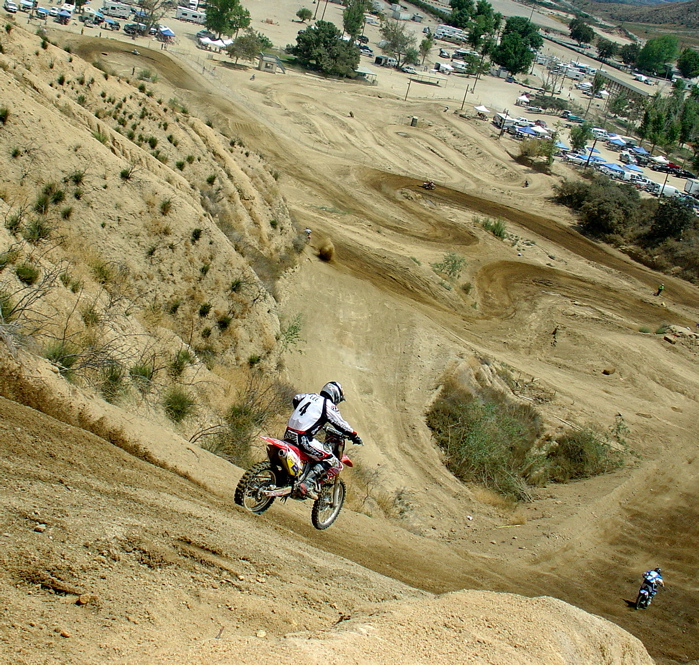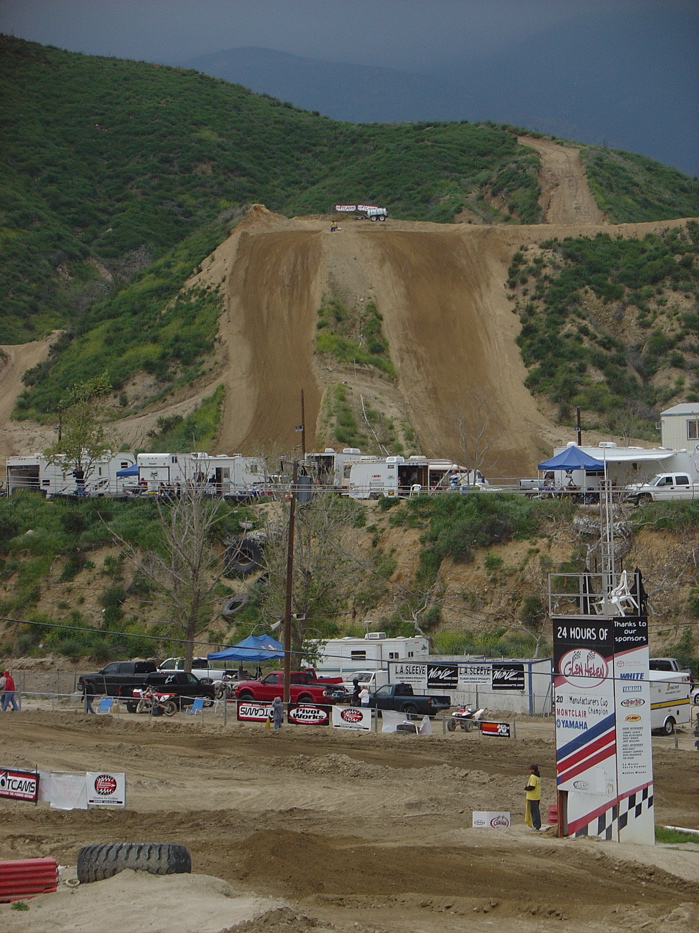JODY’S TRACK DESIGNER’S DIARY: BUILDING THE 2006 GLEN HELEN NATIONAL TRACK

I love Disneyland. I can’t help myself–even though they have, over their history, refused entrance to people with long hair, been caught up in labor disputes, suffered accusations from special interest groups and demanded that people turn their CZ T-shirts inside out before being allowed in the park. Still, you gotta love a giant conglomerate that can mix pleasure with torture. I am pained by the corporate evil behind the joy at Disneyland, but I still get misty for my childhood when I see the riverboat ply its three acres of murky Mississippi. I long for the nonpolitically correct days when the “Jungle Ride” captain used to shoot the fiberglass hippopotamus with his revolver (now they award it an endangered species medal). And who could resist changing cars in the middle of “Haunted House?” I have fond memories of Disneyland; going with my parents when I was seven, taking dates there in the 1970s, getting thrown out in the 1980s (thanks to Mitch Payton and Goat Breker) and being stuck on “Autotopia” when the guy in front of me, who will go nameless, stuck his T-shirt around the axle of his faux-Ferrari.
FROM DISNEY TO GLEN HELEN IN A CATERPILLAR
Disneyland, the Happiest Place on Earth, brings me full circle to the Glen Helen 250/450 AMA National this weekend. I’m big on symbolism, so when I set out to design the 2006 Glen Helen National track I was interested in giving the paying fans the whole Mickey, Minnie and Goofy entertainment experience. Thrills and chills were the order of the day. I wanted to build a track that put a smile on the faces of 20,000 sun-drenched, beer soaked, roosted and roasted race fans.
.
To get 20,000 fans into the track it takes a lot of signs.
AN 11-YEAR-OLDS CONTRIBUTION TO MT. SAINT HELEN
I first started designing Glen Helen’s National tracks in 1997, with the help of Larry Brooks, by building Mt. Saint Helen. It was instantly the biggest hill on the AMA National circuit. I maximized the smaller Shoei Hill by adding an elevator-style downhill and eventually, over time, blended in Yamaha Hill, which is actually taller and steeper than Mt. Saint Helen. For 2006 I added another hill, Mt. Whitney, on the North side of the valley. I’m not fixated on hills, but Glen Helen in a valley with steep hills on each side. If I didn’t put hills in, the track would be narrow and flat.
The giant hills are icing, more like frosting, because although they are visually striking, they aren’t very difficult to climb for a talented rider. How do I know, apart from riding the track with my own meager skills? When I first built the hills I tested them with a 85cc Novice rider (who is now a 250 National rider himself). So, I was quite surprised when the AMA showed up in 1997 and said, “Those hills are too steep to be climbed.” Voila! I trotted out my 11-year-old Novice and, after half a dozen passes, the argument was over. It’s not the going up that is hard. The hard part is coming down–more accurately, the easy part is coming down, the hard part is getting stopped at the bottom. Whatever speed you generate in the first 50 feet at the top of the downhill is the slowest you will go for the rest of the way. Even with the brakes on, you pick up speed on Mt. Saint Helen, Yamaha Hill and Mt. Whitney. All the uphills are cool to watch, the downhills separate the men from the boys (and the boys from their BVDs).

THE DILEMMA OF THE FIRST TURN
One of my biggest dilemmas with designing the Glen Helen track from the very beginning was that the position of the concrete starting gate required a right-hand first turn. Many tracks have right-hand first turns, but they shouldn’t. It is wrong and it can be dangerous. All first turns should be left-hand turns. The pre-1997 Glen Helen had a terrible first turn. It was a 90-degree right about 150 feet off the gate. Since everybody was leaning to the right, with their legs out, nobody had brakes. The pileups looked like Interstate truck accidents, only without the hogs and chickens. I had no intention of inheriting this bottleneck first turn. Roger DeCoster, who had promoted the 1993 AMA National and early 1990s FIM 500 GPs at Glen Helen, suggested that I go as far as I could go before I turned right. Most people said that this would be more dangerous, because the bikes would be going faster, but Roger was right. The farther the 40-man field went, the more they spread out. I experimented in the late 1990s with a right-hand sweeper and a left-hand hairpin. It worked, but I didn’t like they way it single-filed the riders at the start of the race. I needed a better solution. I needed a solution that didn’t involve brakes. So I built the “Talladega” first turn.
You can’t appreciate Talladega without going wide-open around it. It is a 45-degree banked first turn that wraps 180 degrees and is 55 feet tall. The riders hit it at 60 plus and never shut off. It is wide enough for the riders to be seven wide. It is high enough that no one has ever gone over the top. And it is, in my opinion, the safest first turn in motocross history (but the scariest looking). The riders don’t crash because they have no reason to change their lines, slow down or chop the guy behind them. Enamored with the banking, I have made it bigger, steeper and more encompassing with each passing year. this year it is bigger, steeper and wider than ever.

Mt. Whitney in the background has never been used on the National track before 2006.
THE FANS DESERVE MORE FROM A TRACK THAN JUST DIRT
There is a paradox in building a race track. It is a no-win situation. Too easy and you don’t challenge the riders, reward their skills or test their physical fitness. Too hard and you don’t need the race, you can just plant a kiss of Ricky Carmichael’s cheek and call it a day. But the fans deserve more than another Ricky Rout?they need to see motocross, as it was meant to be; physically demanding, scary fast and technically tricky. That is all I ever wanted to give them–whether they want it or not.
I don’t care much about doubles. Doubles force the rider, fast or slow, to land on the landing ramp. It is an easily mastered skill, and one that has turned Supercross into little more than a freestyle conga line. But, I’m not anti-jump–just opposed to jumps that don’t do anything to thin out the herd. This year I have added two monster jumps?known up to this point as “the triple-step-ups.” I first tested the triple step-up at the Prequel race in May, but left it alone for June and July before putting it back into the track three weeks ago. It is jumpable?on three levels. A rider can tabletop the first jump and step-up from the second to third jump. Or, as most 250F riders will do, jump from the face of the table top to the second level (then launch off the third level). The ultimate version is to jump all the way from the tabletop to the third level (which is about 100 feet in distance and 40 feet in elevation). I think that the fastest 450 guys will be able to do the triple step-up all the way, but it might be out of the range of most 250F guys. I had Mike Alessi jump the whole thing two weeks ago, and after he made it on his 250SXF, I moved the third level ten feet farther up the hill.
The first triple step-up is followed by a second one. It is really two tabletops spaced far enough apart that if the rider doesn’t step all the way to the top of the first triple step-up, he will have trouble making it all the way from the first table top to the backside of the second table top. If a 450 riders clears the first triple, he will clear the second triple (and won’t have to land on top of the second tabletop).
There are a few more jumps, but each one has a graduated component that allows a rider to choose how brave he wants to be. You can jump to one level, two levels or three levels. But you don’t have to.
Perhaps the coolest jump, and simplest for a National Pro to do, is the step-down from the REM pits to the floor of the National track. It is designed to send the riders 20 feet into the air and then over a 40 foot drop-off. The cumulative height will be awesome.

Antonio Balbi fails to step-up to the second level of the three level triple step-up. Mt. Whitney is in the background.
I wish I could tell you that designing a race track is fun. It’s not. It’s a full-time job (and understand that I don’t take any money for the work I do). I’ve been at Glen Helen every day for the last three weeks (and rarely has the temperature dropped below 100 degrees, although the weatherman does predict cooler weather for Sunday–maybe 90). I started on the National track back in April. I met with the AMA’s Steve Whitelock several times, talked to him on the phone every week and took Doc Bodner for a tour of the new ambulance road a week before the Prequel.
My dream would be to design a track on paper and point it out to the track crew from the comfort of an air conditioned truck. It’s not like that. Every inch has to be walked and every movement of a Cat has to be coordinated. And, for some unknown reason, if you design the track, you are responsible for miles of fencing, the hospitality areas for the big sponsors, the porta-cans and the location of the concession stands. Track designing isn’t about turns and jumps, it is about water trucks, fire hoses, entrance gates, porta-cans and four miles of chain link fence–then, and only then, it is about turns and jumps. Remember, I tested this track layout at a big race in May, what did I do from May until September. I planned the fencing.
COVERING ALL THE BASES AND STILL WONDERING
I have tried to think of every contingency. For example: After talking to Danny Magoo Chandler last week I was concerned about wheelchair access. Danny gave me his thoughts and Dr. Bud Feldkamp, who owns the track, gave up prime grandstand real estate for a special wheelchair access spectating spot. Every injured fan will be able to go into a grassy area, with trees and shade, and bring three friends with him. The friends will get to sit in the bleachers on the front straight and the view from in front of the fence will be unimpeded for those in wheelchairs. We will bring EZ-Ups into the wheelchair access area and have a handicap ready porta-can on site. Additionally, there is a second handicap area in front of the new tower–which is ramp equipped and is inside the fence to make sure that no one blocks their view. Every National track should do something special for injured riders (and I know that Budds Creek has gone to great lengths to treat people right).

This is the view from the the S-Turn to Mt. Whitney (with the water tank on top).
A lot of my time, and that of other good people, was wasted trying to accommodate the AMA’s demand that all National starts be from a dirt starting area. It wasn’t that many years ago that they AMA wanted National tracks to put in concrete starting lines. Glen Helen did just that, but now we’ve had to buy a totally new gate and install it in front of the old gate to meet this new rule (we will remove it and use the old gate after the National is over). This rule is stupid. In a four-stroke world, with virtually no two-strokes, starting on concrete is as fair as humanly possible. There are no wiggly ruts, wet spots or bottomless pits on concrete. It would have made more sense for the AMA to suggest a dirt start or, for those tracks that complied with the AMA’s previous wishes and put concrete in, to asked that the concrete be grooved to guarantee 100 percent traction. Dirt starts get rutted up unevenly. Concrete is always the same (from gate one to gate 40). Not only is it fairer, but from a track builder’s point of view it doesn’t need any maintenance between motos.
MY HOPES AND DREAMS FOR YOU AND YOURS
My hope when building a track? Wall-to-wall action. I don’t want spectators to plop down in one spot and hold ground like a tenant squatter. I want them to move around. Get up into the roost at Talladega as 40 bikes whiz by like circus riders in the Wall of Doom. Root for the guys who refuse to shut off. Climb to the top of Mt. Saint Helen. The view from the top is like nothing you’ve ever seen. Make sure that you get to the REM side–that is where the wild stuff will really happen. If you’ve never seen two triple step-ups (back-to-back) you don’t want to miss it.
I REMOVED CLASSIC STUFF; SO SHOOT ME
Do I have some regrets about what I built for this the 2006 race. Yes. Because of AMA fencing rules I had to take out the sand whoop section that was located below Talladega. There was no way to meet the AMA’s rules and have that section of track there. I moved the sand down to the final turn before the Log Cabin jump. I also took out the 110-foot tabletop on the back straight (in fact I eliminated the back straight and sand whoops in Buds Creek). Glen Helen is parking motor homes on the site of the big tabletop, but don’t cry for that jump, the triple step-up is 50 yards away and much more spectacular. The muddy straight, known as Flounder Freeway, probably won’t be as muddy as in the past. Why not? Because the entrance to it is now a sweeping left-hand bend, so we will tone the mud down a little–but not eliminate it.
No matter who wins, the 2006 Glen Helen National promises to provide a thrill ride on a par with the best that Disneyland can offer. I hope you like my track. I know one thing for sure, the National riders who have a bad day won’t like it because it will be too rough, too fast, too steep, too difficult. But, the riders who do well will like it. No, they won’t. They will think that it is too rough, too fast, too steep, too difficult. The only person that I can promise you that is going to like it is me–because it will be done and I can go home after the second moto.




Comments are closed.